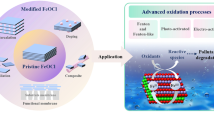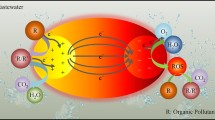Abstract
In the quest for advanced water treatment via Fenton and Fenton-like reactions, minimizing the hydrogen peroxide (H2O2) usage by improving its activation efficiency is a critical goal. Here we report a metal oxyhalide (MOX)-based Fenton reaction system that differs fundamentally from traditional ones in pollutant removal pathway and mechanism. The MOX/H2O2 system enables efficient coupling and polymerization of organic pollutants via mild surface direct oxidation, bypassing the generation of reactive oxygen species. As a result, pollutants are translocated and removed from water with ultralow H2O2 consumption, avoiding the formation of toxic by-products. It achieves up to 80% pollutant (50% total organic carbon) removal at a H2O2-to-pollutants molar ratio of 2:1, outperforming conventional Fenton systems, which are operated at ratios ranging from 20:1 to 1,000:1. The success of these catalytic systems is attributed to the synergistic actions of O-bridging M and X sites on the catalyst surface, which selectively activate pollutants and H2O2, respectively. The catalyst could be extended to low-cost and environmentally benign MOX materials such as BiOI, FeOCl and VOCl, and be adopted to construct a dynamic membrane filtration catalytic system for high-performance and energy-saving abatement of micropollutants in water, providing a promising water purification paradigm.







Similar content being viewed by others
Explore related subjects
Discover the latest articles, news and stories from top researchers in related subjects.Data availability
All data are available in the article and Supplementary Information.
References
Lau, S. S. et al. Toxicological assessment of potable reuse and conventional drinking waters. Nat. Sustain. 6, 39–46 (2022).
Perry, S. C. et al. Electrochemical synthesis of hydrogen peroxide from water and oxygen. Nat. Rev. Chem. 3, 442–458 (2019).
Miller, C. J., Chang, Y., Wegeberg, C., McKenzie, C. J. & Waite, T. D. Kinetic analysis of H2O2 activation by an iron(III) complex in water reveals a nonhomolytic generation pathway to an iron(IV) oxo complex. ACS Catal. 11, 787–799 (2021).
Xu, X. et al. Revealing *OOH key intermediates and regulating H2O2 photoactivation by surface relaxation of Fenton-like catalysts. Proc. Natl Acad. Sci. USA 119, e2205562119 (2022).
Enami, S., Sakamoto, Y. & Colussi, A. J. Fenton chemistry at aqueous interfaces. Proc. Natl Acad. Sci. USA 111, 623–628 (2014).
Glaze, W. H., Kang, J. W. & Chapin, D. H. The chemistry of water treatment processes involving ozone, hydrogen peroxide and ultraviolet radiation. Ozone 9, 335–352 (1987).
Heycock, C. T. & Mills, W. H. Dr. H. J. H. Fenton, F.R.S. Nature 123, 248–249 (1929).
Technical Specifications of Fenton Oxidation Process for Wastewater Treatment HJ 1095-2020 (Ministry of Ecology and Environment of China, 2020).
Xing, M. Y. et al. Metal sulfides as excellent co-catalysts for H2O2 decomposition in advanced oxidation processes. Chem 4, 1359–1372 (2018).
Lyu, L. & Hu, C. Heterogeneous Fenton catalytic water treatment technology and mechanism. Prog. Chem. 29, 981–999 (2017).
Zhu, Y. P. et al. Strategies for enhancing the heterogeneous Fenton catalytic reactivity: a review. Appl. Catal. B 255, 117739 (2019).
Hou, L. et al. Shape-controlled nanostructured magnetite-type materials as highly efficient Fenton catalysts. Appl. Catal. B 144, 739–749 (2014).
Vasseghian, Y., Almomani, F., Le, V. T., Moradi, M. & Dragoi, E. N. Decontamination of toxic malathion pesticide in aqueous solutions by Fenton-based processes: degradation pathway, toxicity assessment and health risk assessment. J. Hazard. Mater. 423, 127016 (2022).
Zhu, Z. et al. Catalytic degradation of recalcitrant pollutants by Fenton-like process using polyacrylonitrile-supported iron (II) phthalocyanine nanofibers: intermediates and pathway. Water Res. 93, 296–305 (2016).
Zhan, S. et al. Efficient Fenton-like process for pollutant removal in electron-rich/poor reaction sites induced by surface oxygen vacancy over cobalt–zinc oxides. Environ. Sci. Technol. 54, 8333–8343 (2020).
Lyu, L., Yan, D., Yu, G., Cao, W. & Hu, C. Efficient destruction of pollutants in water by a dual-reaction-center Fenton-like process over carbon nitride compounds–complexed Cu(II)–CuAlO2. Environ. Sci. Technol. 52, 4294–4304 (2018).
Xu, J. W. et al. Organic wastewater treatment by a single-atom catalyst and electrolytically produced H2O2. Nat. Sustain. 4, 233–241 (2021).
Wang, L., Cao, M., Ai, Z. & Zhang, L. Dramatically enhanced aerobic atrazine degradation with Fe@Fe2O3 core–shell nanowires by tetrapolyphosphate. Environ. Sci. Technol. 48, 3354–3362 (2014).
Yang, Z. C., Qian, J. S., Yu, A. Q. & Pan, B. C. Singlet oxygen mediated iron-based Fenton-like catalysis under nanoconfinement. Proc. Natl Acad. Sci. USA 116, 6659–6664 (2019).
Jiang, Y. et al. In situ turning defects of exfoliated Ti3C2 mxene into Fenton-like catalytic active sites. Proc. Natl Acad. Sci. USA 120, e2210211120 (2023).
Fu, H. et al. Axial coordination tuning Fe single-atom catalysts for boosting H2O2 activation. Appl. Catal. B 321, 122012 (2023).
Wang, L. et al. Notable light-free catalytic activity for pollutant destruction over flower-like BiOI microspheres by a dual-reaction-center Fenton-like process. J. Colloid Interface Sci. 527, 251–259 (2018).
Sen Gupta, S. et al. Rapid total destruction of chlorophenols by activated hydrogen peroxide. Science 296, 326–328 (2002).
Huang, M. et al. Facilely tuning the intrinsic catalytic sites of the spinel oxide for peroxymonosulfate activation: from fundamental investigation to pilot-scale demonstration. Proc. Natl Acad. Sci. USA 119, e2202682119 (2022).
Liu, C., Zhang, G., Zhang, W., Gu, Z. & Zhu, G. Specifically adsorbed ferrous ions modulate interfacial affinity for high-rate ammonia electrosynthesis from nitrate in neutral media. Proc. Natl Acad. Sci. USA 120, e2209979120 (2023).
Xia, J. et al. Self-assembly and enhanced photocatalytic properties of BiOI hollow microspheres via a reactable ionic liquid. Langmuir 27, 1200–1206 (2011).
Cheng, H., Huang, B. & Dai, Y. Engineering BiOX (X = Cl, Br, I) nanostructures for highly efficient photocatalytic applications. Nanoscale 6, 2009–2026 (2014).
Ling, C. et al. Atomic-layered Cu5 nanoclusters on FeS2 with dual catalytic sites for efficient and selective H2O2 activation. Angew. Chem. Int. Ed. 61, e202200670 (2022).
Ren, Y. et al. Enhancing the Fenton-like catalytic activity of nFe2O3 by MIL-53Cu support: a mechanistic investigation. Environ. Sci. Technol. 54, 5258–5267 (2020).
Zhang, Y.-J. et al. Simultaneous nanocatalytic surface activation of pollutants and oxidants for highly efficient water decontamination. Nat. Commun. 13, 3005 (2022).
Zhang, Y. J. et al. Distinguishing homogeneous advanced oxidation processes in bulk water from heterogeneous surface reactions in organic oxidation. Proc. Natl Acad. Sci. USA 120, e2302407120 (2023).
Hay, A. S. Polymerization by oxidative coupling. 2. Oxidation of 2,6-disubstituted phenols. J. Polym. Sci. 58, 581–591 (1962).
Maeno, Z., Mitsudome, T., Mizugaki, T., Jitsukawa, K. & Kaneda, K. Selective C–C coupling reaction of dimethylphenol to tetramethyldiphenoquinone using molecular oxygen catalyzed by Cu complexes immobilized in nanospaces of structurally-ordered materials. Molecules 20, 3089–3106 (2015).
Maeno, Z. et al. Regioselective oxidative coupling of 2,6-dimethylphenol to tetramethyldipheno-quinone using polyamine dendrimer-encapsulated Cu catalysts. RSC Adv. 3, 9662–9665 (2013).
Zhao, Y., Wu, L. B., Li, B. G. & Zhu, S. P. The effect of ligand molecular weight on copper salt catalyzed oxidative coupling polymerization of 2,6-dimethylphenol. J. Appl. Polym. Sci. 117, 3473–3481 (2010).
Gupta, S., van Dijk, J. A. P. P., Gamez, P., Challa, G. & Reedijk, J. Mechanistic studies for the polymerization of 2,6-dimethylphenol to poly(2,6-dimethyl-1,4-phenylene ether): LC-MS analyses showing rearrangement and redistribution products. Appl. Catal. A 319, 163–170 (2007).
Wang, J. L. et al. Interlayer structure manipulation of iron oxychloride by potassium cation intercalation to steer H2O2 activation pathway. J. Am. Chem. Soc. 144, 4294–4299 (2022).
Yu, J., Taylor, K. E., Zou, H. X., Biswas, N. & Bewtra, J. K. Phenol conversion and dimeric intermediates in horseradish peroxidase-catalyzed phenol removal from water. Environ. Sci. Technol. 28, 2154–2160 (1994).
Yamaguchi, R., Kurosu, S., Suzuki, M. & Kawase, Y. Hydroxyl radical generation by zero-valent iron/Cu (ZVI/Cu) bimetallic catalyst in wastewater treatment: heterogeneous Fenton/Fenton-like reactions by Fenton reagents formed in-situ under oxic conditions. Chem. Eng. J. 334, 1537–1549 (2018).
Jain, B., Singh, A. K., Kim, H., Lichtfouse, E. & Sharma, V. K. Treatment of organic pollutants by homogeneous and heterogeneous Fenton reaction processes. Environ. Chem. Lett. 16, 947–967 (2018).
Huang, G. X. et al. Ultrasensitive fluorescence detection of peroxymonosulfate based on a sulfate radical-mediated aromatic hydroxylation. Anal. Chem. 90, 14439–14446 (2018).
Gentry, E. C. & Knowles, R. R. Synthetic applications of proton-coupled electron transfer. Acc. Chem. Res. 49, 1546–1556 (2016).
Hammes-Schiffer, S. Proton-coupled electron transfer: moving together and charging forward. J. Am. Chem. Soc. 137, 8860–8871 (2015).
Weinberg, D. R. et al. Proton-coupled electron transfer. Chem. Rev. 112, 4016–4093 (2012).
Yang, C. W., Hu, Y., Yuan, L., Zhou, H. Z. & Sheng, G. P. Selectively tracking nanoparticles in aquatic plant using core–shell nanoparticle-enhanced Raman spectroscopy imaging. ACS Nano 15, 19828–19837 (2021).
Liu, T. et al. Water decontamination via nonradical process by nanoconfined Fenton-like catalysts. Nat. Commun. 14, 2881 (2023).
Wang, N. et al. Impact of ozonation on naphthenic acids speciation and toxicity of oil sands process-affected water to and mammalian immune system. Environ. Sci. Technol. 47, 6518–6526 (2013).
Ben, W. et al. Occurrence, removal and risk of organic micropollutants in wastewater treatment plants across China: comparison of wastewater treatment processes. Water Res. 130, 38–46 (2018).
Lotfi, S., Fischer, K., Schulze, A. & Schafer, A. I. Photocatalytic degradation of steroid hormone micropollutants by TiO-coated polyethersulfone membranes in a continuous flow-through process. Nat. Nanotechnol. 17, 417–423 (2022).
He, R. et al. Priority control sequence of 34 typical pollutants in effluents of Chinese wastewater treatment plants. Water Res. 243, 120338 (2023).
Zhang, X., Ai, Z. H., Jia, F. L. & Zhang, L. Z. Generalized one-pot synthesis, characterization, and photocatalytic activity of hierarchical BiOX (X = Cl, Br, I) nanoplate microspheres. J. Phys. Chem. C 112, 747–753 (2008).
Yang, X. J., Xu, X. M., Xu, J. & Han, Y. F. Iron oxychloride (FeOCl): an efficient Fenton-like catalyst for producing hydroxyl radicals in degradation of organic contaminants. J. Am. Chem. Soc. 135, 16058–16061 (2013).
Gao, P. et al. VOCl as a cathode for rechargeable chloride ion batteries. Angew. Chem. Int. Ed. 55, 4285–4290 (2016).
Clark, S. J. et al. First principles methods using CASTEP. Z. Kristallogr. 220, 567–570 (2005).
Perdew, J. P., Burke, K. & Ernzerhof, M. Generalized gradient approximation made simple. Phys. Rev. Lett. 77, 3865–3868 (1996).
Acknowledgements
This work was supported by the National Natural Science Foundation of China (51821006, 52192684 and 52027815 to H.-Q.Y.; 51978637 to J.-J.C.; and 52300114 to Y.-J.Z.) and the Instruments Center for Physical Science at the University of Science and Technology of China (USTC). The numerical calculations in this work were conducted on the supercomputing system in the Supercomputing Center of the USTC.
Author information
Authors and Affiliations
Contributions
Y.-J.Z. came up with the original idea. H.-Q.Y. and J.-J.C. supervised the project. Y.-J.Z., Y.H., W.-W.L., H.-Q.Y. and J.-J.C. designed the experiments. Y.-J.Z., J.-S.T. and Y.H. performed the experiments and the characterizations. G.-X.H. and Y.P. helped with the data interpretations. Y.-J.Z., W.-W.L., J.-J.C. and H.-Q.Y. wrote and revised the paper. All authors commented on the paper.
Corresponding authors
Ethics declarations
Competing interests
The authors declare no competing interests.
Peer review
Peer review information
Nature Water thanks Jeonghun Kim and the other, anonymous, reviewer(s) for their contribution to the peer review of this work.
Additional information
Publisher’s note Springer Nature remains neutral with regard to jurisdictional claims in published maps and institutional affiliations.
Supplementary information
Supplementary Information
Supplementary Materials and Methods, Figs. 1–39 and Tables 1–8.
Source data
Source Data Figs. 1–7
Statistical source data.
Rights and permissions
Springer Nature or its licensor (e.g. a society or other partner) holds exclusive rights to this article under a publishing agreement with the author(s) or other rightsholder(s); author self-archiving of the accepted manuscript version of this article is solely governed by the terms of such publishing agreement and applicable law.
About this article
Cite this article
Zhang, YJ., Tao, JS., Hu, Y. et al. Metal oxyhalide-based heterogeneous catalytic water purification with ultralow H2O2 consumption. Nat Water 2, 770–781 (2024). https://doi.org/10.1038/s44221-024-00281-y
Received:
Accepted:
Published:
Issue Date:
DOI: https://doi.org/10.1038/s44221-024-00281-y
- Springer Nature Limited





